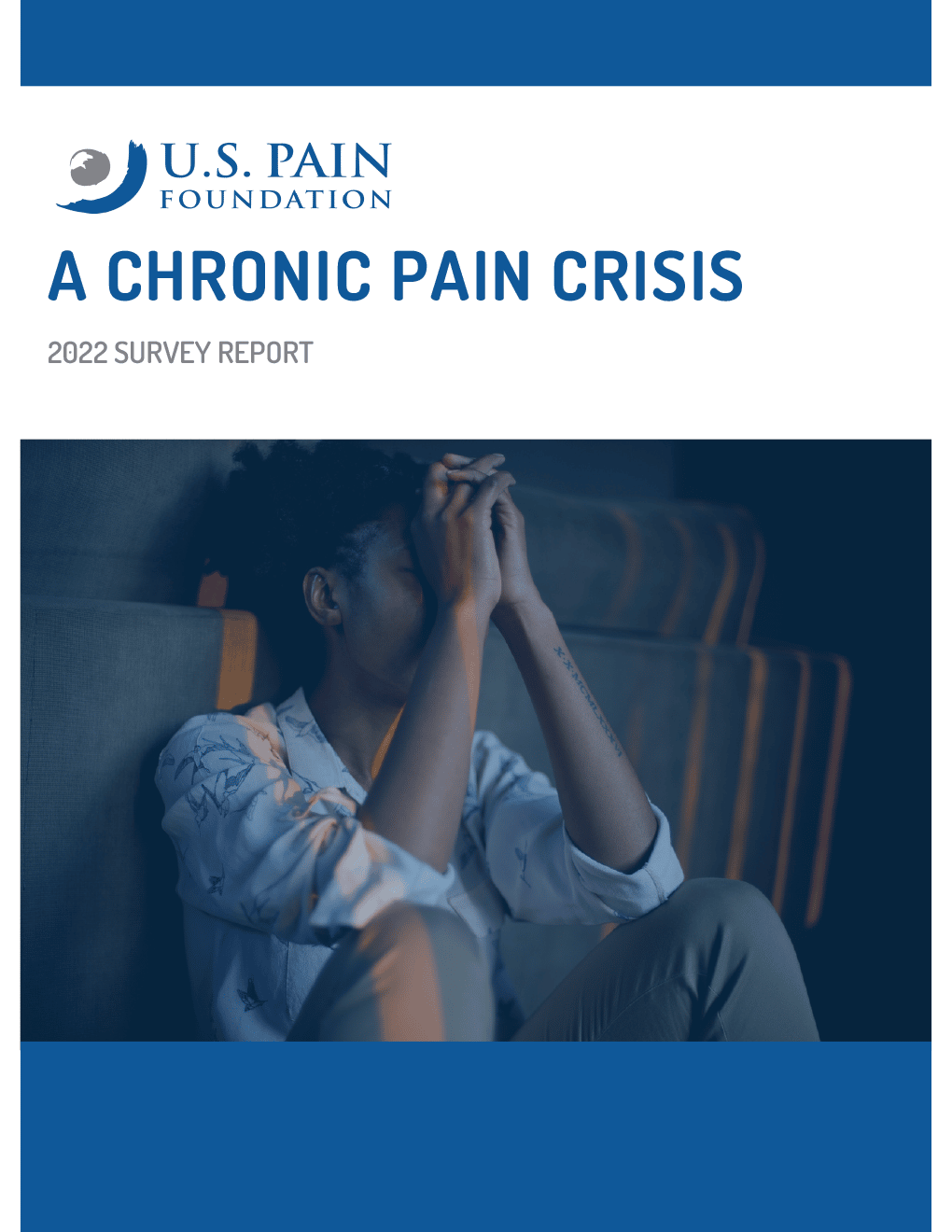A Chronic Pain Crisis
Pulling back the veil on the public health crisis that is chronic pain.
Between March 29 to April 12, 2022, U.S. Pain Foundation conducted a survey of 2,378 individuals to better understand the public health crisis of chronic pain. Respondents included 2,275 people with chronic pain (96%), defined as pain lasting three months or more, as well as 72 caregivers (3%) and 31 health care professionals (1%).
Topics explored included types of pain, ability to work, patient-provider relationships, cost, treatment options, concerns about side effects, mental health, COVID-19, and mobility issues.
The results underscore the devastating impact of chronic pain on quality of life.
Key Findings
1. Chronic pain has devastating consequences on function, quality of life, and mental health.
- More than half (52%) said their average pain level is 7 or more on a scale of 1-10.
- 99% said pain has restricted their ability to engage in routine activities, like exercise, household chores, sleeping, and socializing.
- 95% of respondents had at least one comorbidity.
- More than two-thirds (71%) of respondents said they considered themselves disabled.
- Only 18% are employed full-time.
- 60% said they feel anxiety-like symptoms daily or a few times a week, and a similar portion (59%) feel depression-like symptoms daily or a few times a week.
- 79% said they feel stigmatized because of pain.
2. At best, people with pain feel their health care providers are not equipped to manage their pain effectively; at worst, people with pain feel unsupported and stigmatized.
- Approximately 63% of respondents felt stigmatized by their providers.
- Patients report that core competencies expected of providers treating pain are lacking.
- 24% “rarely” or “never” felt validated or listened to;
- 69% either did not feel, or only “rarely” or “sometimes” felt that their provider was on a team with them; and,
- 53% answered “no” or only “sometimes” when asked if their provider helped them understand options for managing their pain.
- When asked about their top pain policy issue, the most common answer was increased pain education for providers (41%), tied with wanting new medications for chronic pain.
- 71% of caregivers said “provider attitudes” are the top barrier to care.
3. Medications remain the most effective treatment option, but people with pain face significant barriers in accessing certain drugs.
- Nearly all respondents (79%) currently take prescription medications.
- A majority (77%) said prescription medications are the most helpful treatment in managing their pain.
- One-quarter (24%) said no side effect would prevent them from trying a medication to manage pain.
- Nearly half of respondents take opioid medications (47%), although three-quarters of that group report a range of substantial barriers to obtaining their medications. Barriers faced by those taking opioid medications include: decreased doses, stigmatization, and providers refusing to fill medications or outright refusing to treat the person with pain at all.
- Nearly all (94%) of those taking opioids said they attribute these barriers to the 2016 CDC opioid guideline.
- Roughly one-fifth (19%) of people with pain currently use medical cannabis.
- 43% of individuals in states where it is illegal said they would try medical cannabis if it were legalized.
4. Multidisciplinary approaches, particularly self-management techniques, are under-recognized components of effective pain management.
- Multidisciplinary approaches were widely employed, with the top strategies including activity restriction or modification (73%), stress reduction techniques (42%), heat therapy (41%), and meditation and mindfulness (40%).
- Activity restriction or modification is the most-used specific “therapy” of any kind across all categories, aside from prescription medications as an entire category (79%).
- Similarly, prescriptions were reported as the most helpful category of treatment (77%); self-management techniques as a whole were next at 31%, above OTC medications (27%), assistive devices or braces (24%), supplements, vitamins, or herbs (22%), medical cannabis (21%), mind-body and behavioral health options (20%), and interventional procedures and surgeries (17%).
- Less than one-fifth (19%) of people with pain had heard of the Pain Management Best Practices Report, a national set of recommendations that outlines the importance of multidisciplinary pain care.
5. Due to high out-of-pocket costs—coupled with pain’s drastic impact on the ability to work—cost remains the primary barrier to pain care.
- Approximately one-third (33%) of people with pain had a total annual household income of less than $35,000.
- According to people with pain, the leading barrier to treatment was cost (49%).
- Nearly half (41%) of people with pain said they felt insurance coverage decisions are driven by cost, not by what was in their best interest medically.

